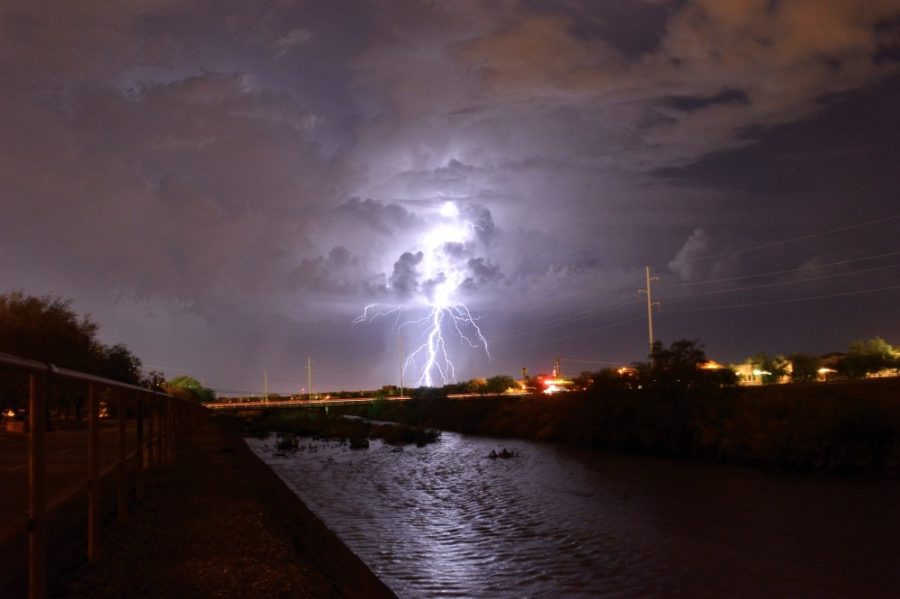According to a new report, Pima County experiences an average of 47 extreme weather events annually, from dust storms and hail to thunderstorms and flash floods.
Published by two UA School of Government and Public Policy researchers, assistant professor Laura Bakkensen and graduate student Riana Johnson, the report is entitled “The Economic Impacts of Extreme Weather: Tucson and Southern Arizona’s Current Risks and Future Opportunities.”
The report compares Tucson to other metropolitan statistical areas (MSAs) in the West, according to Bakkensen, using data from the National Weather Service. She clarified that the figures come from all the counties in the MSA, which could lead to some differences in results if the data is processed differently.
Bakkensen said Tucson’s higher average compared to other MSAs likely comes from the highly localized nature of weather events, especially during the monsoon.
“Maybe Denver has a winter storm over the entire city that’s just one event, where Tucson might have multiple events during a couple days in the monsoon because they’re smaller storms,” Bakkensen said.

Johnson said that climate-related factors are also behind Tucson’s higher average.
“There’s some indication in scientific literature about how we are in a certain climate that allows for more extreme events to occur,” Johnson said.
RELATED: Antarctic ballooning: UA professor to lead NASA study
Overall, the report found that since 2010 Arizona has suffered more than $3 billion in damages from extreme weather. This average of $500 million per year equals more than 5 percent of the state government’s annual operating budget, according to the report.
Bakkensen said that figure also came from National Weather Service data. She and Johnson adjusted the amounts for inflation to ensure accuracy. However, she said there is no universal accounting standard for damages.
“They’re very interesting numbers, but we need to be careful because it’s not an exact, to-the-cent dollar figure,” Bakkensen said. “But it gives us a ballpark about relative magnitudes.”
One of the best ways to reduce damages, according to Bakkensen, is simply having accurate information readily available to the public.
“One of the most important things is staying up-to-date on really good, quality information, because in the minutes and hours before extreme weather, there’s a lot we can do to actually help protect our lives and prevent injuries, and we can also help protect our property,” Bakkensen said.
Johnson pointed to social media as an up-and-coming way to get information out fast.
RELATED: Climate oscillations give clue of 2017 weather
“Utilizing technology as a means of getting the proper information is going to be really important in the future,” Johnson said. “There’s been some new research on the effects of social media on weather messages and informing people, and I think that’s really useful, utilizing cell phones and text alerts.”
Pima County has started to send out text alerts about weather in addition to the usual Amber alerts, according to Johnson, who also said the Arizona Department of Transportation has social media campaigns out on Twitter that seem effective.
Bakkensen said that while information itself doesn’t necessarily reduce damages, it can help people make better decisions by allowing them to modify their behavior.
“One of the things that can happen is since we get a lot of extreme weather, we might not think it’s as bad, we might become more relaxed about it,” Bakkensen said. “But each individual event could lead to property damage, could lead to injury, so keep that in mind, so we don’t discount the risk just because we’ve experienced some things before and we were okay.”
Another important factor in reducing economic damages is insurance, according to the report. Bakkensen said looking at the cost versus benefit in considering different kinds of insurance for different kinds of extreme weather is a good idea.
“One of the advantages of insurance is that is kind of smooths these losses over time, so instead of having a big damage to your house and having to pay for all of it yourself at one point in time, you have a much lower premium every year, and then you know you’ll be covered in case something bad happens,” Bakkensen said.
The report is available online at the Making Access Possible Dashboard website.
Follow Marissa Heffernan on Twitter.









